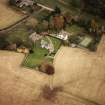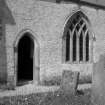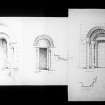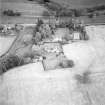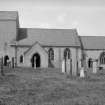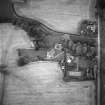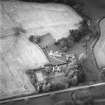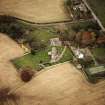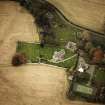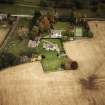Stobo Parish Church
Church (12th Century), War Memorial (20th Century)
Site Name Stobo Parish Church
Classification Church (12th Century), War Memorial (20th Century)
Alternative Name(s) Stobo Kirk
Canmore ID 49854
Site Number NT13NE 9
NGR NT 18271 37654
Datum OSGB36 - NGR
Permalink http://canmore.org.uk/site/49854
First 100 images shown. See the Collections panel (below) for a link to all digital images.
- Council Scottish Borders, The
- Parish Stobo
- Former Region Borders
- Former District Tweeddale
- Former County Peebles-shire
Stobo, Peeblesshire, tegulated coped monument fragment
Measurements: L 0.27m, W 0.18m, H 0.23m
Stone type: sandstone
Place of discovery: NT 18271 37654
Present location: in Stobo Church.
Evidence for discovery: first recorded by RCAHMS in 1962.
Present condition: trimmed for re-use.
Description
This was a steep-sided coped monument. The fragment shows three rows of trapezoid tegulae.
Date range: twelfth century.
Primary references: Lang 1974, 232.
Desk-based information compiled by A Ritchie 2019
NT13NE 9 18271 37654.
(NT 1827 3765 ) Church (NAT)
OS 6" map, (1967).
Stobo parish church, which was dedicated to St Mungo, dates from the 12th century, but the numerous later additions and alterations to the fabric, together with the harled exterior, make a complete structural analysis difficult. The existing evidence suggests that the building originally comprised a simple rectangular nave, a square-ended chancel and a W tower, though the slight variation between the axes of the tower and nave suggest that possibly the tower may be an addition. The N transeptal chapel, which dates from the 15th century was reconstructed in 1928 on the mistaken supposition that it was a hermit's cell and an early nucleus of the whole fabric. The S porch is of 15th/16th century date, and on its W side there is a glazed case containing a pair of jougs.
The church was restored in 1863.
RCAHMS 1967, visited 1962.
Dedicated to St Mungo and St Kentigern this church is as described and in normal use.
Visited by OS(RD) 23 June 1971.
A watching brief and survey were completed over 5 days during the installation of a new central heating system within the nave of the church. Disturbed graves were identified, suggesting that the floor
was lowered during the 17th century, along with evidence that the west wall of the nave and tower were remodelled from earlier masonry. Sponsor: Stobo and Drumelzier Parish Council.
G Ewart 1991.
Photographic Record (1896)
Photograph album with views from the Scottish Borders in 1896 including Peebles
Publication Account (1985)
In medieval times St Mungo's ofStobo was the most important church in the upper Tweed Valley, centrally sited to serve the later parishes of Stobo, Lyne, Broughton, Drumelzier and Tweedsmuir, and close to the all-important east-west route through the Biggar Gap.
The original 12th century church comprised a rectangular nave, a square-headed chancel and a west tower which, not quite square to the church, may have been built separately and certainly seems to have been rebuilt above first-floor level in the 16th century. Surviving Norman features include the plain, semicircular south doorway-now approached through a 15th-16th century stone-bench lined porch whose jambs have been grooved by children, so it is said, sharpening slate-pencils in the days when the parish school was housed within! A further Norman doorway, now a window, stands in the north wall of the nave; in the north wall of the chancel, two roundheaded slits, originally 12th century, retain faint traces of painted decoration.
In the 15th-16th century, the porch and two windows were added to the south wall and a much wider window to the east chancel wall. Of similar pre-Reformation date are the lower parts of the north chapel, originally a mortuary or chantry chapel, and almost completely rebuilt in 1928.
The church has some fine monuments, notably three recumbent tombstones set in the north chapel walls. One commemorates Robert Vessy, died 1473, sometime vicar of S toboi another an unknown warrior. Probably dating to the first half 16th century, this reveals a grotesque, crudely inscribed figure of an armoured man lying on his back, hands clasped on his chest and feet splayed. The third stone, fragmentary, bears an incised mill-rynd and probably recalls a miller. Considerably earlier is part of a 12th century coped stone, with a shingle-type decoration.
Outside, a set ofjougs-a favourite early 18th century instrument of ecclesiastical discipline- hang beside the porch; in the churchyard stand a number of good 17th-18th century grayestones. John Noble's stone (1723) for instance, has a fine full-length figure in contemporary costume and with a flintlock guni that to Elisabeth Agnas and Elizabeth Thomson (1723) pictures the united family group on an end-panel to a table-tomb; yet another (c 1730) shows a youth, perhaps of the Cunningham family, wearing a longskirted coat with broad cuffs at the wrists. A remarkable collection.
Information from 'Exploring Scotland's Heritage: Lothian and Borders', (1985).
Excavation (1 November 1990 - 2 November 1990)
A watching brief and survey were completed over 5 days during the installation of a new central heating system within the nave of the church. Disturbed graves were identified, suggesting that the floor was lowered during the 17th century, along with evidence that the west wall of the nave and tower were remodelled from earlier masonry.
G Ewart 1991
Sponsor: Stobo and Drumelzier Parish Council.
Kirkdale Archaeology
Sbc Note
Visibility: This is an upstanding building.
Information from Scottish Borders Council.













































































































